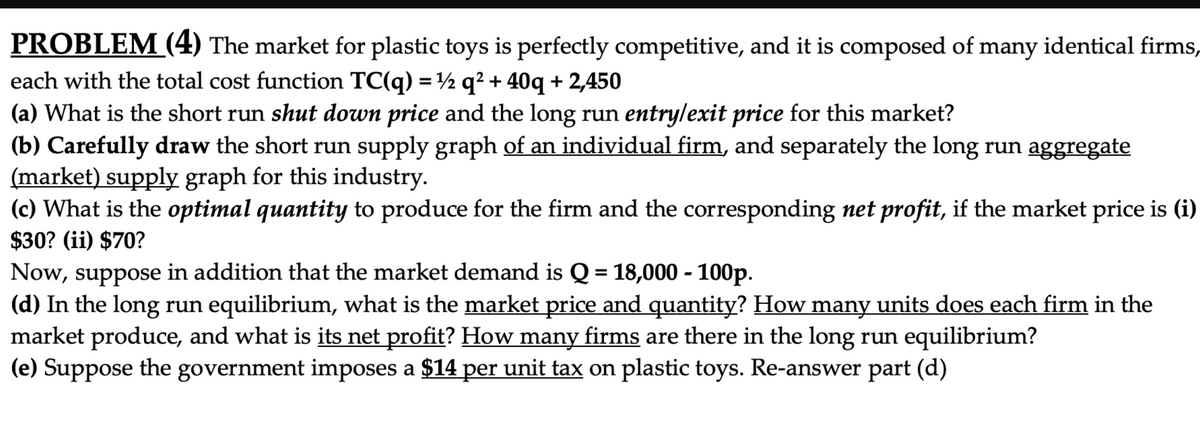Now, suppose in addition that the market demand is Q = 18,000 - 100p. (d) In the long run equilibrium, what is the market price and quantity? How many units does each firm in the market produce, and what is its net profit? How many firms are there in the long run equilibrium? (e) Suppose the government imposes a $14 per unit tax on plastic toys. Re-answer part (d)
Now, suppose in addition that the market demand is Q = 18,000 - 100p. (d) In the long run equilibrium, what is the market price and quantity? How many units does each firm in the market produce, and what is its net profit? How many firms are there in the long run equilibrium? (e) Suppose the government imposes a $14 per unit tax on plastic toys. Re-answer part (d)
Managerial Economics: Applications, Strategies and Tactics (MindTap Course List)
14th Edition
ISBN:9781305506381
Author:James R. McGuigan, R. Charles Moyer, Frederick H.deB. Harris
Publisher:James R. McGuigan, R. Charles Moyer, Frederick H.deB. Harris
Chapter11: Price And Output Determination: Monopoly And Dominant Firms
Section: Chapter Questions
Problem 6E
Related questions
Question
I need help with part d) and e) only!

Transcribed Image Text:PROBLEM (4) The market for plastic toys is perfectly competitive, and it is composed of many identical firms,
each with the total cost function TC(q) = ½ q² + 40q + 2,450
(a) What is the short run shut down price and the long run entry/exit price for this market?
(b) Carefully draw the short run supply graph of an individual firm, and separately the long run aggregate
(market) supply graph for this industry.
(c) What is the optimal quantity to produce for the firm and the corresponding net profit, if the market price is (i)
%3D
$30? (ii) $70?
Now, suppose in addition that the market demand is Q = 18,000 - 100p.
(d) In the long run equilibrium, what is the market price and quantity? How many units does each firm in the
market produce, and what is its net profit? How many firms are there in the long run equilibrium?
(e) Suppose the government imposes a $14 per unit tax on plastic toys. Re-answer part (d)
%3D
Expert Solution
This question has been solved!
Explore an expertly crafted, step-by-step solution for a thorough understanding of key concepts.
Step by step
Solved in 2 steps

Knowledge Booster
Learn more about
Need a deep-dive on the concept behind this application? Look no further. Learn more about this topic, economics and related others by exploring similar questions and additional content below.Recommended textbooks for you

Managerial Economics: Applications, Strategies an…
Economics
ISBN:
9781305506381
Author:
James R. McGuigan, R. Charles Moyer, Frederick H.deB. Harris
Publisher:
Cengage Learning

Managerial Economics: Applications, Strategies an…
Economics
ISBN:
9781305506381
Author:
James R. McGuigan, R. Charles Moyer, Frederick H.deB. Harris
Publisher:
Cengage Learning